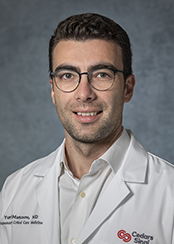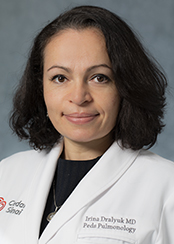Cystic Fibrosis Program Offers New Hope to Patients
Date
June 22, 2022

Date
June 22, 2022
Credits
Medical providers featured in this article


In Brief
{{cta-block}}
Cystic fibrosis is a genetic disease that affects an estimated 35,000 Americans. People with cystic fibrosis have a genetic mutation that causes bodily secretions to become thick and sticky, and that can compromise multiple organ systems, including the lungs and pancreas.
Once a neglected disease that robbed children of their lives before they became teens, cystic fibrosis has emerged as a treatable condition, with patients living into their 30s, 40s and 50s.
"With today's targeted treatments, the majority of cystic fibrosis patients have a longer life and a better quality of life than they did even five years ago," says Dr. Irina Dralyuk, a pediatric pulmonologist.
Dr. Dralyuk and Dr. Yuri Matusov are spearheading the new Bronchiectasis and Cystic Fibrosis Program at Cedars-Sinai.
{{providers}}
"Today, people with cystic fibrosis can go to school, work and lead a 'normal life.' That's a game-changer for these patients and their families."
How cystic fibrosis is diagnosed
Since cystic fibrosis is part of standard newborn screening in the U.S., babies born with cystic fibrosis are typically diagnosed within the first months of life.
Some people with cystic fibrosis show signs of the disease during infancy, but people who have milder cases may not exhibit signs of cystic fibrosis until their teenage years or even later.
"The symptoms of cystic fibrosis vary depending on the specific mutation you have, which organ systems are affected and the severity of the disease," says Dr. Dralyuk. "Symptoms may even change in the same person over time."
People with cystic fibrosis may suffer from breathing difficulties and severe lung infections since thick mucus is more difficult to clear. Their bodies also might have difficulty absorbing nutrients and breaking down food effectively in their digestive system.
Treatment for cystic fibrosis
Historically, patients with cystic fibrosis died before they reached adulthood, so most cystic fibrosis programs focused on pediatrics. Now that cystic fibrosis patients are living full lives—often into middle age—there's a growing push for services targeted to adults with cystic fibrosis.
"When people with cystic fibrosis graduate from pediatric care, there's often a difficult transition to an adult care program," Dr. Dralyuk says. "Our goal with the Cystic Fibrosis Program is to integrate pediatric care and adult care so patients have a smooth transition and continuity of care."
As part of the Cystic Fibrosis Program at Cedars-Sinai, patients see specialists from a variety of disciplines, including pulmonologists, endocrinologists, nutritionists, physical therapists, respiratory therapists, gastroenterologists, geneticists and social workers.
Clinicians also strive to get cystic fibrosis patients moving with an individualized exercise program tailored to each patient's specific abilities.
"We see the best results when we assess each patient's baseline activity level and then build on their ability to exercise, rather than starting everyone with the same standard protocol," Dr. Dralyuk says.
Improving quality of life for children and adults with cystic fibrosis
Over the past few years, the development of new treatments coupled with advancements in medications for symptom management have dramatically improved the quality of life for people with cystic fibrosis.
"While cystic fibrosis is still a progressive disease, now we're able to identify patients' mutations and prescribe corrective medication so they have normal secretions," says Dr. Dralyuk.
"We have better therapies for airway clearance and a better understanding of the infectious diseases that affect cystic fibrosis patients, so we're able to target antibiotics more effectively."
Outpatient treatment options for cystic fibrosis patients
It used to be that patients with cystic fibrosis received most of their care in the hospital as inpatients. With today's targeted therapies and advanced treatments, cystic fibrosis is now primarily managed on an outpatient basis.
"Today, people with cystic fibrosis can go to school, work and lead a 'normal life,'" says Dr. Dralyuk. "That's a game-changer for these patients and their families."





